Learninsta presents the core concepts of Biology with high-quality research papers and topical review articles.
Functions Of Ecosystem
The function of ecosystem include creation of energy creation, sharing of energy and cycling of materials between the living and nonliving components of an ecosystem. Before studying the productivity in any ecosystem, we should understand the essential role of sunlight used by producers of the first trophic level. The quantity of sunlight is directly proportional to the production of energy by plants.
Photosynthetically Active Radiation (PAR)
The amount of light available for photosynthesis of plants is called Photosynthetically Active Radiation (PAR) which is from of 400-700 nm in wave length. It is essential for photosynthesis and plant growth. PAR is not always constant because of clouds, tree shades, air, dust particles, seasons, latitudes and length of the daylight availability. Generally plants absorb more blue and red light for efficient photosynthesis.
Of the total sunlight, 34 percent that reaches the atmosphere is reflected back into the atmosphere, moreover 10% is held by ozone, water vapours and atmospheric gases and the remaining 56% reaches the earth’s surface. Out of this 56%, only 2 – 10% of the solar energy is used by green plants for photosynthesis while the remaining portion is dissipated as heat.
PAR is generally expressed in millimoles / square meter / second by using silicon photo voltic detectors which detect only 400 – 700 nm wavelength of light. PAR values range from 0 to 3000 millimoles / square meter / second.
At night PAR is zero and during midday in the summer, PAR oftn reaches 2000 – 3000 millimoles / square meter / second.
Productivity of an ecosystem
The rate of biomass production per unit area in a unit time is called productivity. It can be expressed in terms of gm / m2 / year or Kcal / m2 / year. It is classified as given below.
- Primary productivity
- Secondary productivity
- Community productivity
1. Primary productivity:
The chemical energy or organic matter generated by autotrophs during the process of photosynthesis and chemosynthesis is called primary productivity. It is the source of energy for all organisms, from bacteria to human.
a. Gross Primary Productivity (GPP)
The total amount of food energy or organic matter or biomass produced in an ecosystem by autotrophs through the process of photosynthesis is called gross primary productivity.
b. Net Primary Productivity (NPP)
The proportion of energy which remains after respiration loss in the plant is called net primary productivity. It is also called as apparent photosynthesis. This the difference between GPP and respiration is known as NPP.
NPP = GPP – Respiration
NPP of whole biosphere is estimated to be about 170 billion tons (dry weight) per year. Out of which NPP of oceanic producers is only 55 billion tons per year in unit time.
2. Secondary productivity
The amount of energy stored in the tissues of heterotrophs or consumers is called secondary productivity.
a. Gross secondary productivity
It is equivalent to the total amount of plant material is ingested by the herbivores minus the materials lost as faeces.
b. Net secondary productivity
Storage of energy or biomass by consumers per unit area per unit time, after respiratory loss is called net secondary productivity.
3. Community productivity
The rate of net synthesis of organic matter (biomass) by a group of plants per unit area per unit time is known as community productivity.
Factors affecting primary productivity
Primary productivity depends upon the plant species of an area, their photosynthetic capacity, availability of nutrients, solar radiation, precipitation, soil type, topographic factors (altitude, latitude, direction), and other environmental factors. It varies in different types of ecosystems.
Concept of trophic level in an ecosystem
(Greek word ‘trophic’ = to food or feeding)
A trophic level refers to the position of an organism in the food chain. The number of trophic levels is equal to the number of steps in the food chain. The green plants (producers) occupying the first trophic level (T1) are called producers. The energy produced by the producers is utilized by the plant eaters (herbivores) they are called primary consumers and occupy the second trophic level (T2).
Herbivores are eaten by carnivores, which occupy the third trophic level (T3). They are also called secondary consumers or primary carnivores. Carnivores are eaten by the other carnivores, which occupy the fourth trophic level (T4). They are called the tertiary consumers or secondary carnivores. Some organisms which eat both plants and animals are called as omnivores (Crow). Such organisms may occupy more than one trophic level in the food chain.
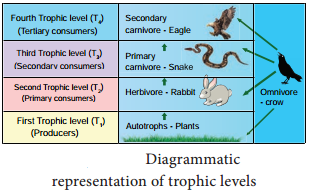
Energy flow
The transfer of energy in an ecosystem between trophic levels can be termed as energy flow. It is the key function in an ecosystem. Part of the energy obtained from the sun by producers is transferred to consumers and decomposers through each trophic level, while some amount of energy is dissipated in the form of heat. Energy flow is always unidirectional in an ecosystem.
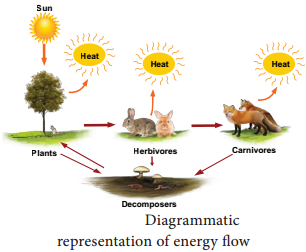
Laws of thermodynamics
The storage and loss of energy in an ecosystem is based on two basic laws of thermo-dynamics.
(i) First law of thermodynamics
It states that energy can be transmitted from one system to another in various forms. Energy cannot be destroyed or created. But it can be transformed from one form to another. As a result, the quantity of energy present in the universe is constant.
Example:
In photosynthesis, the product of starch (chemical energy) is formed by the combination of reactants (chlorophyll, H2O, CO2). The energy stored in starch is acquired from the external sources (light energy) and so there is no gain or loss in total energy. Here light energy is converted into chemical energy.

Light energy → chemical energy
(ii) Second law of thermodynamics
It states that energy transformation results in the reduction of the free energy of the system. Usually energy transformation cannot be 100% efficient. As energy is transferred from one organism to another in the form of food, a portion of it is stored as energy in living tissue, whereas a large part of energy is dissipated as heat through respiration. The transfer of energy is irreversible natural process. Example: Ten percent law
Ten percent law
This law was proposed by Lindeman (1942). It states that during transfer of food energy from one trophic level to other, only about 10% stored at every level and rest of them (90%) is lost in respiration, decomposition and in the form of heat. Hence, the law is called ten percent law. Example: It is shown that of the 1000 Joules of Solar energy trapped by producers. 100 Joules of energy is stored as chemical energy through photosynthesis.
The remaining 900 Joules would be lost in the environment. In the next trophic level herbivores, which feed on producers get only 10 Joules of energy and the remaining 90 Joules is lost in the environment.
Likewise, in the next trophic level, carnivores, which eat herbivores store only 1 Joule of energy and the remaining 9 Joules is dissipated. Finally, the carnivores are eaten by tertiary consumers which store only 0.1 Joule of energy and the remaining 0.9 Joule is lost in the environment. Thus, at the successive trophic level, only ten percent energy is stored.
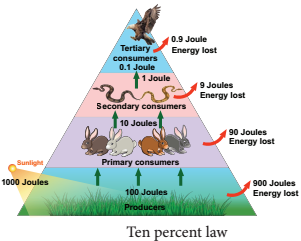
Food chain:
The movement of energy from producers upto top carnivores is known as food chain, i.e., in any food chain, energy flows from producers to primary consumers, then from primary consumers to secondary consumers, and finally secondary consumers to tertiary consumers. Hence, it shows linear network links. Generally, there are two types of food chain, (1) Grazing food chain and (2) Detritus food chain.
1. Grazing food chain:
Main source of energy for the grazing food chain is the Sun. It begins with the first link, producers (plants). The second link in the food chain is primary consumers (mouse) which get their food from producers. The third link in the food chain is secondary consumers (snake) which get their food from primary consumers. Fourth link in the food chain is tertiary consumers (eagle) which get their food from secondary consumers.
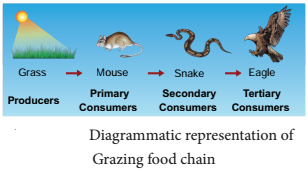
2. Detritus food chain:
This type of food chain begins with dead organic matter which is an important source of energy. A large amount of organic matter is derived from the dead plants, animals and their excreta. This type of food chain is present in all ecosystems.
The transfer of energy from the dead organic matter, is transferred through a series of organisms called detritus consumers (detritivores) – small carnivores – large (top) carnivores with repeated eating and being eaten respectively. This is called the detritus food chain.

Food Web
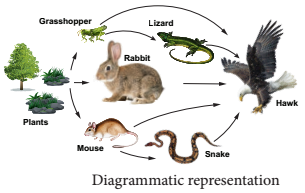
The inter-locking pattern of a number of food chain form a web like arrangement called food web. It is the basic unit of an ecosystem, to maintain its stability in nature. Which is also called homeostasis. Example: In a grazing food chain of a grass land, in the absence of a rabbit, a mouse may also eat food grains. The mouse in turn may be eaten directly by a hawk or by a snake and the snake may be directly eaten by hawks.
Hence, this interlocking pattern of food chains is the food web and the species of an ecosystem may remain balanced to each other by some sort of natural check.
Signifiance of food web
- • Food web is constructed to describe species interaction called direct interaction.
- It can be used to illustrate indirect interactions among different species.
- It can be used to study bottom-up or topdown control of community structure.
- It can be used to reveal different patterns of energy transfer in terrestrial and aquatic ecosystems.
Ecological pyramids
Graphic representation of the trophic structure and function at successive trophic levels of an ecosystem is called ecological pyramids. The
concept of ecological pyramids was introduced by Charles Elton (1927). Thus they are also called as Eltonian pyramids.
There are three types:
- pyramid of number
- pyramid of biomass
- pyramid of energy.
1. Pyramid of number
A graphical representation of the number of organisms present at each successive trophic level in an ecosystem is called pyramids of number. There are three different shapes of pyramids upright, spindle and inverted.
There is a gradual decrease in the number of organisms in each trophic level from producers to primary consumers and then to secondary consumers, and finally to tertiary consumers. Therefore, pyramids of number in grassland and pond ecosystem are always upright.
In a forest ecosystem the pyramid of number is somewhat different in shape, it is because the base (T1) of the pyramid occupies large sized trees (Producer) which are lesser in number. Herbivores (T2) (Fruit eating birds, elephant, deer) occupying second trophic level, are more in number than the producers. In final trophic level (T4), tertiary consumers (lion) are lesser in number than the secondary consumer (T3) (fox
and snake). Therefore, the pyramid of number in forest ecosystem looks spindle shaped.
The pyramid of number in a parasite ecosystem is always inverted, because it starts with a single tree. Therefore there is gradual increase in the number of organisms in successive tropic levels from producer to tertiary consumers.
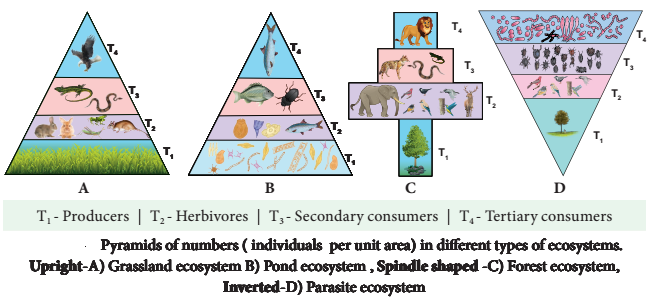
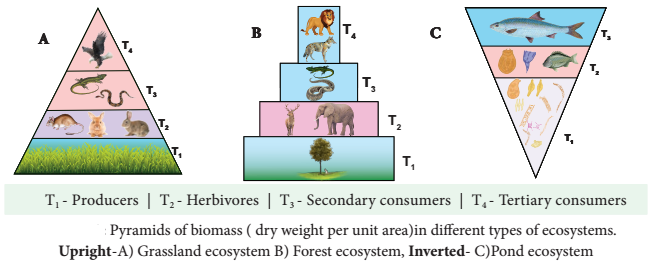
2. Pyramid of biomass
A graphical representation of the amount of organic material (biomass) present at each successive trophic level in an ecosystem is called pyramid of biomass.
In grassland and forest ecosystems, there is a gradual decrease in biomass of organisms at successive trophic levels from producers to top carnivores (Tertiary consumer). Therefore, these two ecosystems show pyramids as upright pyramids of biomass.
However, in pond ecosystem, the bottom of the pyramid is occupied by the producers, which comprise very small organisms possessing the least biomass and so, the value gradually increases towards the tip of the pyramid. Therefore, the pyramid of biomass is always inverted in shape.
3. Pyramid of energy
A graphical representation of energy flow at each successive trophic level in an ecosystem is called pyramid of energy. The bottom of the pyramid of energy is occupied by the producers. There is a gradual decrease in energy transfer at successive tropic levels from producers to the upper levels. Threfore, the pyramid of energy is always upright.
Decomposition:
Decomposition is a process in which the detritus (dead plants, animals and their excreta) are breaken down in to simple organic matter by the decomposers. It is an essential process for recycling and balancing the nutrient pool in an ecosystem.
Nature of decomposition
The process of decomposition varies based on the nature of the organic compounds, i.e., some of the compounds like carbohydrate, fat and protein are decomposed rapidly than the cellulose, lignin, chitin, hair and bone.
Mechanism of decomposition
Decomposition is a step wise process of degradation mediated by enzymatic reactions. Detritus acts as a raw material for decomposition. It occurs in the following steps.
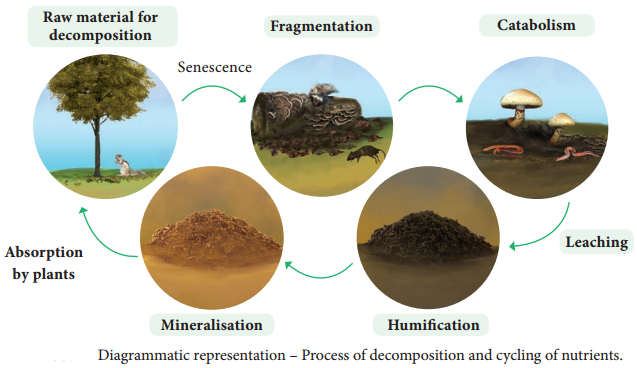
a. Fragmentation – The breaking down of detritus into smaller particles by detritivores like bacteria, fungi and earth worm is known as fragmentation. These detritivores secrete certain substances to enhance the fragmentation process and increase the surface area of detritus particles.
b. Catabolism – The decomposers produce some extracellular enzymes in their surroundings to break down complex organic and inorganic compounds in to simpler ones. This is called catabolism
c. Leaching or Eluviation – The movement of decomposed, water soluble organic and inorganic compounds from the surface to the lower layer of soil or the carrying away of the same by water is called leaching or eluviation.
d. Humifiation – It is a process by which simplified detritus is changed into dark coloured amorphous substance called humus. It is highly resistant to microbial action, therefore decomposition is very slow. It is the reservoir of nutrients.
Mineralisation – Some microbes are involved in the release of inorganic nutrients from the humus of the soil, such process is called mineralisation.
Factors affecting decomposition
Decomposition is affcted by climatic factors like temperature, soil moisture, soil pH, oxygen and also the chemical quality of detritus.
Biogeochemical cycles (Nutrient cycles)
Exchange of nutrients between organisms and their environment is one of the essential aspects of an ecosystem. All organisms require nutrients for their growth, development, maintenance and reproduction. Circulation of nutrients within the ecosystem or biosphere is known as biogeochemical cycles and also called as ‘cycling of materials.’ There are two basic types,
- Gaseous cycle – It includes atmospheric Oxygen, Carbon and Nitrogen cycles.
- Sedimentary cycle – It includes the cycles of Phosphorus, Sulphur and Calcium Which are present as sediments of earth.
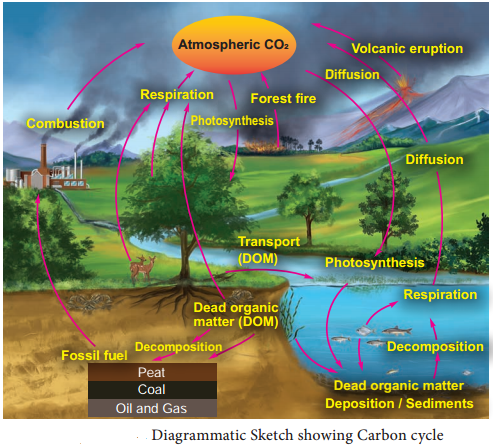
Many of the cycles mentioned above are studied by you in previous classes. Therefore, in this chapter, only the carbon and phosphorous cycles are explained.
Carbon cycle
The circulation of carbon between organisms and environment is known as the carbon cycle. Carbon is an inevitable part of all biomolecules and is substantially impacted by the change in global climate. Cycling of carbon between organisms and atmosphere is a consequence of two reciprocal processes of photosynthesis and respiration.
The releasing of carbon in the atmosphere increases due to burning of fossile fuels, deforestration, forest fire, volcanic eruption and decomposition of dead organic matters. The details of carbon cycle are given in the figure.
Phosphorus cycle
It is a type of sedimentary cycle. Already we know that phosphorus is found in the biomolecules like DNA, RNA, ATP, NADP and phospholipid molecules of living organisms. Phosphorus is not abundant in the biosphere, whereas a bulk quantity of phosphorus is present in rock deposits, marine sediments and guano.
It is released from these deposits by weathering process. After that, it circulates in lithosphere as well as hydrosphere. The producers absorb phosphorus in the form of phosphate ions, and then it is transferred to each trophic level of food chain through food.
Again death of the organisms and degradation by the action of decomposers, the phosphorus is released back into the lithosphere and hydrosphere to maintain phosphorus cycle.
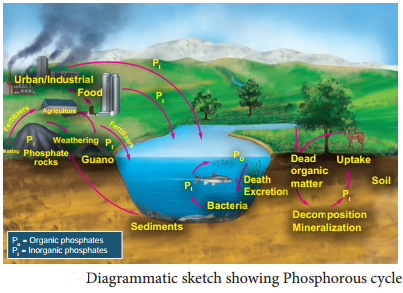
Types of ecosystem
Biosphere consists of diffrent types of ecosystems, which are as follows:
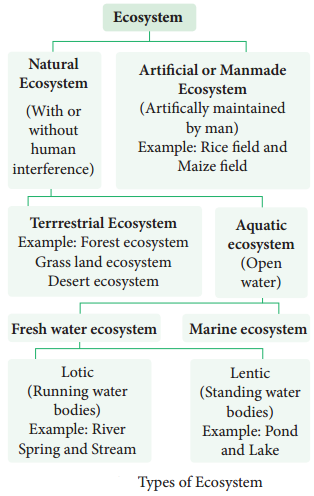
Though there are many types of ecosystems as charted above. Only the pond ecosystem is detailed below.
Structure of Pond ecosystem
It is a classical example for natural, aquatic, freshwater, lentic type of ecosystem. It helps us to understand the structure and function of an ecosystem. When rain water gathers in a shallow area, gradually over a period of time, different kinds of organisms (microbes, plants, animals) become part of this ecosystem. This pond ecosystem is a self sustaining and self regulatory fresh water ecosystem, which shows a complex interaction between the abiotic and biotic components in it.
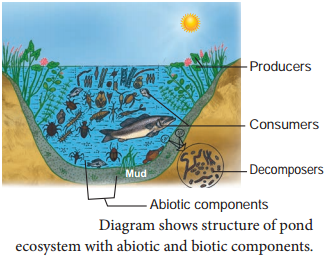
Abiotic components
A pond ecosystem consists of dissolved inorganic (CO2, O2, Ca, N, Phosphate) and organic substances (amino acids and humic acid) formed from the dead organic matter. The function of pond ecosystem is regulated by few factors like the amount of light, temperature, pH value of water and other climatic conditions.
Biotic components
They constitute the producers, variety of consumers and decomposers (microorganisms).
a. Producers
A variety of phytoplanktons like Oscillatoria, Anabaena, Chlamydomonas, Pandorina, Eudorina, Volvox and Diatoms. Filamentous algae such as Ulothrix, Spirogyra, Cladophora and Oedogonium; flating plants Azolla, Salvia, Pistia, Wolff and Eichhornia; submerged plants Potamogeton and Phragmitis; rooted flating plants Nymphaea and Nelumbo; macrophytes like Typha and Ipomoea, constitute the major producers of a pond ecosystem.
b. Consumers
The animals represent the consumers of a pond ecosystem which include zooplanktons like Paramoecium and Daphnia (primary consumers); benthos (bottom living animals) like mollusces and annelids; secondary consumers like water beetles and frogs; and tertiary consumers (carnivores) like duck, crane and some top carnivores which include large fish, hawk, man, etc.
c. Decomposers
They are also called as microconsumers. They help to recycle the nutrients in the ecosystem. These are present in mud water and bottom of the ponds. Example: Bacteria and Fungi. Decomposers perform the process of decomposition in order to enrich the nutrients in the pond ecosystem. The cycling of nutrients between abiotic and biotic components is evident in the pond ecosystem, making itself self sufficient and self
regulating.
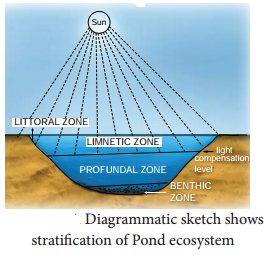
Based on the factors like distance from the shore, penetration of light, depth of water, types of plants and animals, there may be three zones, littoral, limnetic and profundal. The littoral zone, which is closest to the shore with shallow water region, allows easy penetration of light. It is warm and occupied by rooted plant species. The limnetic zone refers the open water of the pond with an effective penetration of light and domination of planktons.
The deeper region of a pond below the limnetic zone is called profundal zone with no effective light penetration and predominance of heterotrophs. The bottom zone of a pond is termed benthic and is occupied by a community of organisms called benthos (usually decomposers). The primary productivity through photosynthesis of littoral and limnetic zone is more due to greater penetration of light than the profundal zone.
Ecosystem services (Benefits)
Ecosystem services are defined as the benefits that people derive from nature. Robert Constanza et al (1927) stated “Ecosystem services are the benefis provided to human, through the transformation of resources (or Environmental assets including land, water, vegetation and atmosphere) into a flow of essential goods and services”.
Study on ecosystem services acts as an effective tool for gaining knowledge on ecosystem benefis and their sustained use. Without such knowledge gain, the fate of any ecosystem will be at stake and the benefits they provide to us in future will become bleak.
How do anthropogenic activities affect ecosystem services?
Now, we all exploit the ecosystem more than that of our needs. The Millennium Ecosystem Assessment (2005) found that “over the past 50 years, humans have changed the ecosystem more rapidly and extensively than in any comparable period of time in human history, largely to meet rapidly growing demands for food, fresh water, medicine, timber, fier and fuel.”
The varieties of benefis obtained from the ecosystem are generally categorized into the following four types
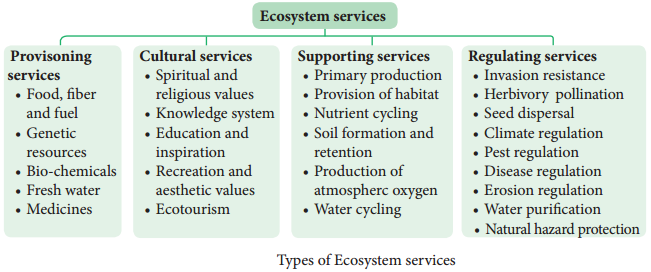
Generally the following human activities disturb or re-engineer an ecosystem every day.
- Habitat destruction
- Deforestation and over grazing
- Erosion of soils
- Introduction of non-native species
- Over harvesting of plant material
- Pollution of land, water and air
- Run of pesticides, fertilizers and animal wastes
How to protect the ecosystem?
It is a practice of protecting ecosystem at individual, organisational and governmental levels for the benefis of both nature and humans. Theats to ecosystems are many, like adverse human activities, global warming, pollution, etc. Hence, if we change our everyday life style, we can help to protect the planet and its ecosystem. “If we fail to protect environment, we will fail to save posterity”.
Therefore, we have to practice the following in our day today life:
- Buy and use only ecofriendly products and recycle them.
- Grow more trees
- Choose sustained farm products (vegetables, fruits, greens, etc.)
- Reduce the use of natural resources.
- Recycle the waste and reduce the amount of waste you produce.
- Reduce consumption of water and electricity.
- Reduce or eliminate the use of house-hold chemicals and pesticides.
- Maintain your cars and vehicles properly. (In order to reduce carbon emission)
- Create awareness and educate about ecosystem protection among your friends and family members.
Ecosystem Management
It is a process that integrates ecological, socio economic and institutional factors into a comprehensive strategy in order to sustain and enhance the quality of the ecosystem to meet current and future needs.
Ecosystem management emphasis on human role in judicious use of ecosystem and for sustained benefis through minimal human impacts on ecosystems. Environmental degradation and biodiversity loss will result in depletion of natural resources, ultimately affecting the existence of human.
Strategy of ecosystem management
- It is used to maintain biodiversity of ecosystems.
- It helps in indicating the damaged ecosystem (Some species indicate the health of the ecosystem: such species are called a flagship species).
- It is used to recognize the inevitability of ecosystem change and plan accordingly.
- It is one of the tools used for achieving sustainability of ecosystem through sustainable development programme (or projects).
- It is also helpful in identifying ecosystems which are in need of rehabilitation.
- It involves collaborative management with government agencies, local population, communities and NGO’s.
- It is used to build the capacity of local institutions and community groups to assume responsibility for long term implementation of ecosystem management activities even after the completion of the project.